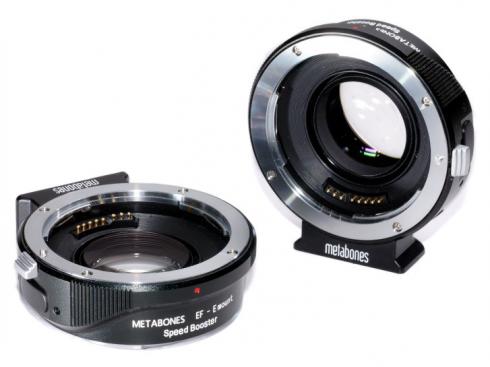Every few years, there is a big shift in the way we create video on low-budget shoots. Ground glass adapters, DSLR filmmaking, firmware hacks, these are all things that had a huge impact on the way we shoot and how the footage looks. The latest major innovation in small-camera filmmaking is the speedbooster. Speedboosters can make your lens faster, sharper, and wider, and reduce your depth of field, all with minimal tradeoffs. To use one effectively, you need to understand a bit of how it works.
All lenses create an image circle. This is the circle of light behind the lens that falls on the sensor or film. A speedbooster takes that circle of light and makes it smaller. As it gets smaller, a few things happen.
- The light gets brighter. If the circle gets .7x smaller, it gets about twice as bright per square mm. This is why .7x speedboosters make your lens one stop faster. You’re not letting in more light, but the same amount of light is concentrated on a smaller area.
- The lens seems wider. As the circle gets smaller, your image sensor can see more of the edges of it. This is what makes it seem wider.
- The image gets sharper. There are a few reasons for this. The main one is simple: all the ‘mistakes’ that a lens makes (unwanted softness, chromatic abberrations, etc.) get .7x smaller through a .7x speedbooster. Everything becomes more precise. There are a few other factors at play, as well. Since you have an extra stop of light available, you can stop down your lens, and lenses usually get sharper when stopped down (at least to f/8 or so). Some speedboosters are designed for specific lens/camera combinations, which means they can compensate for differences on the camera’s sensor stack. All of these factors can combine to improve the image quality of a lens a great deal.
Speedboosters only work if the imaging circle of the lens is wide enough to cover the imaging area of the sensor after the reduction. So adapting full-frame lenses to a APS-C, Super 35, or MFT sensor with a speedbooster is possible. Since there are many fullframe lenses available (including most photography lenses, Zeiss and Schneider fullframe lenses, etc.) there are lots of lens options for people shooting on smaller format cameras.
There are a few ways to think of a speedbooster working, and any of them are a good way to understand how a speedbooster works. Just don’t get them confused and combine them.
You can think of a speedbooster as making your camera’s sensor larger. In this understanding, your lens is the same speed and length. Your camera’s sensor size is modified by the speedbooster conversion. So if you have a 1:2.3 crop factor on your GH4 camera in video mode, it becomes about a 1:1.6 crop with the speedbooster. Since in this understanding, your pixels get bigger, the camera becomes twice as sensitive to light, meaning setting the camera to 800 ISO will cause it to perform like it?s at 1600 ISO. Since the image sensor is larger, the depth-of-field performance will match that of a larger sensor, and the image will be wider. In the GH4’s case, it will behave more like a Canon C300 or 7D.
Alternately, you can think of a speedbooster as changing the properties of your lens. In this understanding, your lens (let’s take a 50mm f/2 for example) becomes .7x wider (35mm) and one stop brighter (f/1.4). Your camera stays the same. This is why certain electronic speedboosters, like those from Metabones, change the f-stop data that is sent to the camera. So your camera’s image would look about the same from a 50mm f/2 on a speedbooster and a 35mm f/1.4 without a speedbooster.
Most of the misunderstandings about speedboosters come from combining these ways of thinking about how they work. The best way to get an understanding of how they affect your image is to rent one, take some sample shots, and practice for yourself.
Speedboosters are possible because of a few quirks of how the DSLR filmmaking revolution worked out. First, 35mm still film is shot on a much larger area than 35mm movie film. So 35mm still lenses have a much larger imaging circle than most 35mm movie lenses. Second, 35mm still cameras required a relatively large gap between the film and the back of the lens (this is called the flange distance). The gap allows for the mirror to move up and out of the way of the shutter (the mirror is what makes it an SLR). Speedboosters take the space that was traditionally used for a mirror and replace it with optics.
Adding a speedbooster to your kit is an excellent way to get the most out of your lenses and cameras, without having to use a bigger, bulkier camera body. And since you only need one speedbooster for each camera, it’s almost like doubling your current collection of lenses.
Jon Kline has been working with film and video for more than ten years. His experience as a cinematographer stretches from commercials to feature films. You can find him at jonkline.com or on twitter @JonKline.






